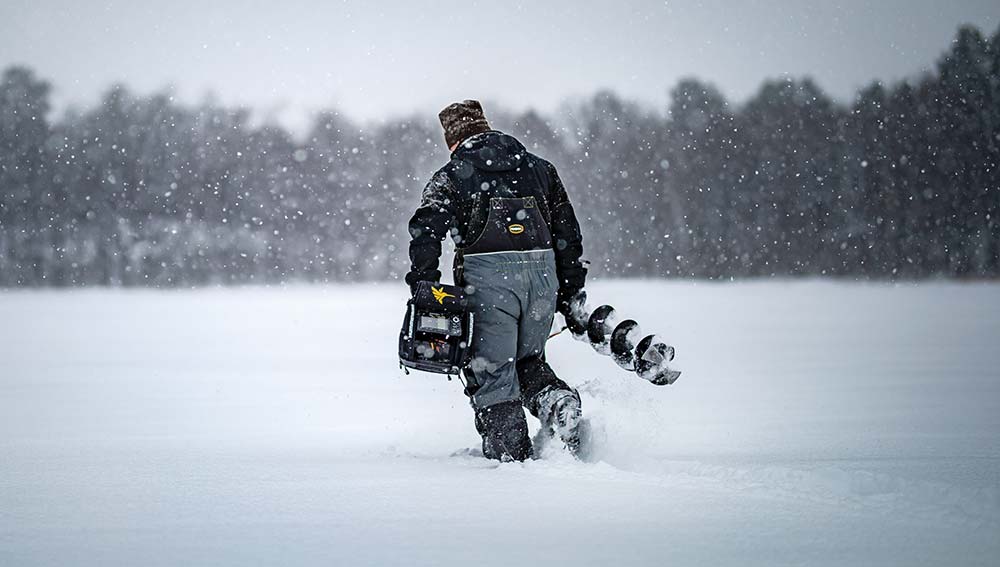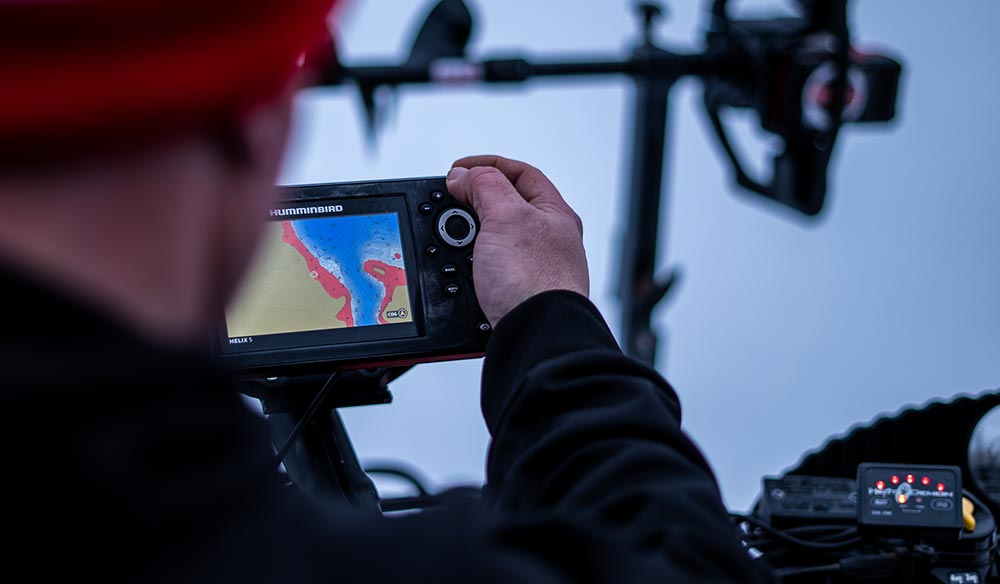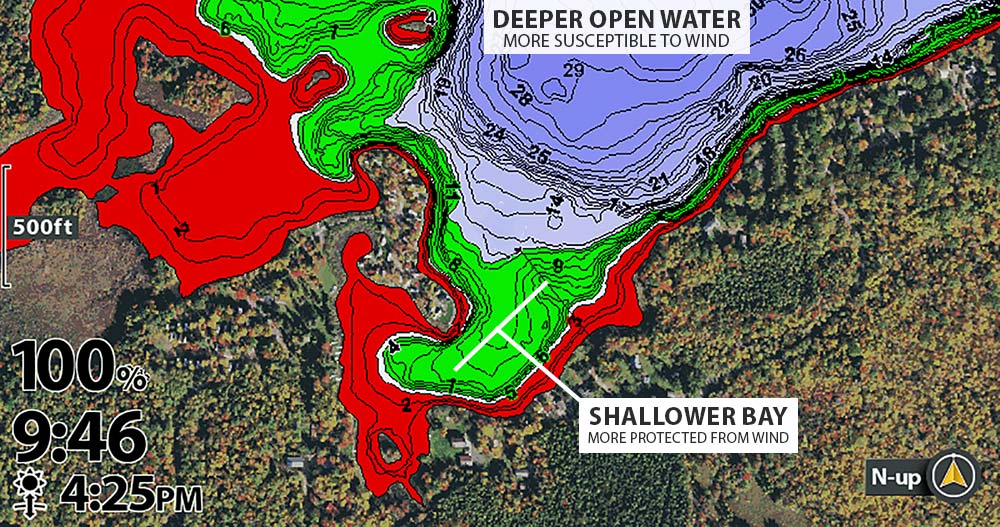Ice Fishing Safety: 10 Tips and Gear List

Is Ice Fishing Safe?
Just like fishing during the summer months, there is always some level of danger, but being aware of your surroundings, taking the appropriate precautions, and having the right mindset and gear, ice fishing can be safe.
By following the tips in this article, you can feel more confident in taking on early season ice fishing for years to come.
Ice Thickness Chart – How much ice is needed to go ice fishing?
You can use this ice thickness chart as a guideline to accessing your favorite ice fishing spot, but you need to consider a few things like flowing water, snow cover, recent weather patterns or warm spells, etc.
*To be used as an estimate, not a rule. Conditions vary and caution should be exercised whenever accessing the ice, whether it be on foot or with a small vehicle.

Generally speaking, it is recommended that the ice be at least 4 inches thick before you attempt to go ice fishing on foot. 6-8 inches for snowmobiles or ATVs and 9-12 inches for UTVs or light vehicles.
Just because you measure 4” of ice in one area near the shoreline does not mean that the whole body of water has 4” of ice on it. You should proceed with caution and utilize some of the gear we list later in the article.
Ice Fishing Safety Tips and Things to Consider
- Do not attempt to ice fish until the ice has reached 4” thick!
- New, clear ice is the safest ice compared to cloudy-looking ice.
- Clear ice has not had the chance to melt or be insulated by snow.
- Ice does not freeze evenly. Just because it is 6” in one area does not mean it is 6” mere feet from your current location. Always test thickness with the tools mentioned below.
- Be Aware of Your Surroundings and Avoid these Areas
- Areas with current or moving water. Ice will not form as strong near moving water. It is best to avoid these areas completely or proceed with extra caution later in the season.
- Avoid slushy areas! Mushy snow and liquid on top of the ice can be a sign of weak ice, melt, or holes/cracks in the ice
- Keep your eyes peeled for large cracks or heaves in the ice
- Warm water discharges and culverts (Flowing water)
- Pay attention to snowfall — especially early in the season or when ice growth is fresh. Not only does it apply pressure to the developed ice, but it also insulates the ice resulting in slower development of new ice and potential melt depending on temps
- Bring the right gear – See our list in the next section
- Fish with a friend and always let someone know about your plans
- Shallow bays protected from the wind will typically generate safe ice first—just be careful of any underground springs or moving water
- After the ice has developed, use caution after recent warm weather—the conditions are unlikely to be the same as the last time you accessed the ice
- Dress appropriately. An obvious one, but make sure to layer your clothing and wear gear designed for ice fishing or very cold temperatures
- Check your local sporting goods store or online retailer for recommended gear
Ice Fishing Safety Gear List
Here are a few ice fishing tools that you should consider having with you at all times when ice fishing, especially early in the season.
- Spud bar or chisel – Used to jab at the ice to determine thickness or strength of ice. Typically, if you can jab the ice twice with force, it is a general rule of thumb that you can walk on it. If water seeps through after one jab, you should probably turn around and head back Here is an example of an ice fishing spud bar from Rapala.
- Ice picks – Lightweight tool that hangs around your neck and in the event that you fall through the ice, you can use these picks to get traction or grip needed and pull yourself out of the water. Ice Safety Picks are a must-have for any ice angler, especially during the early ice season.
- Ruler – or an ice scoop with sharpie lines every inch to check the thickness of the ice.
- Floating Ice Suit or life jacket – Many ice fishing outerwear companies make floating ice suits, but you can always resort to the typical lifejacket or throwable.
- Whistle
- Rope – 50 to 100ft. In the event that you fall through the ice, a rope is a helpful tool for passersby or friends to pull you out without getting too close to the hole.
- Cell phone
- GPS Fish Finder - See three tips in the next section
3 Ways Your Fish Finder Can Help You Stay Safe While Ice Fishing
Having access to an ice fish finder with GPS and cartography can actually be an aid in accessing and getting off of hardwater. Here are a few ways to utilize fish finders like the Humminbird ICE HELIX (with GPS) to access your favorite body of water with confidence.
Using GPS Tracks on Ice

Before you leave the shore, turn on your ICE HELIX and leave it on while you navigate onto the ice. The GPS function will track your route, so as you test the ice and confirm a safe entry onto the body of water, you can then use that track also navigate off of the ice whether you are accessing by foot or vehicle.
This can be really helpful when fishing for long hours or fishing in the evening / after dark. Another situation where it comes in handy is in the event of extreme weather where visibility is compromised or blowing wind and snow covers your entry tracks.

GPS Waypoints to Mark Areas
Marking waypoints of weak ice or areas to avoid is a great way to identify them in low light situations or when snow covers the ice.
Mark areas with large amounts of slush, heaves or large cracks, water discharges, current, or any other signs of weak ice.
Mapping to Identify Ice Development Areas
Lastly, using a premium mapping solution like Humminbird’s LakeMaster Cartography you can identify areas of the lake that may have better ice development. An example would be locating a shallow flat in a bay or protected area from the wind.

As mentioned above, shallow protected areas will typically develop strong ice sooner. Deepwater and open lake areas typically develop ice later due to water depth and wind sweeping across the lake or body of water.
Ice Fishing Resources: How to, tips, and technology
- How to use Mapping for Ice Fishing - (Video + Article) How breaking down a lake into smaller, fishable areas will save you time, effort and result in a more productive day on the ice.
- How to Choose the Best Ice Fish Finder for You - A basic run-down of both flashers and LCD GPS all-in-one combo units to help you decide which is right for you.
- How to Convert a Humminbird HELIX for Ice Fishing - From open water to ice, converting your Humminbird HELIX for ice fishing is simple.
- How Scouting in Fall Open Water Can Help Your Ice Fishing - (Video + Article) How locating fish and bottom transitions in fall is essential to great ice fishing.







